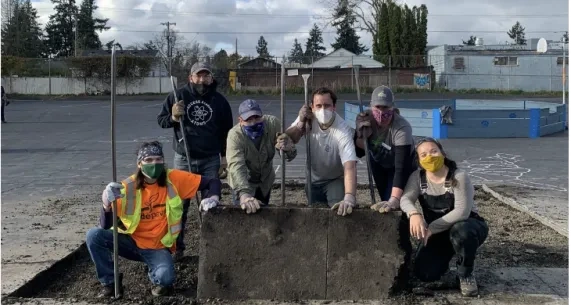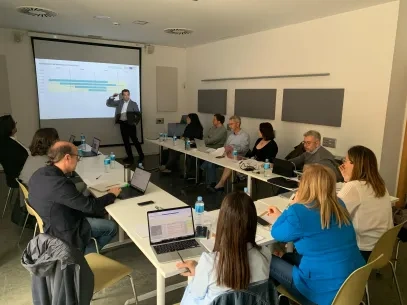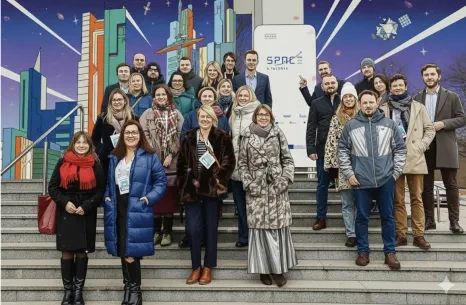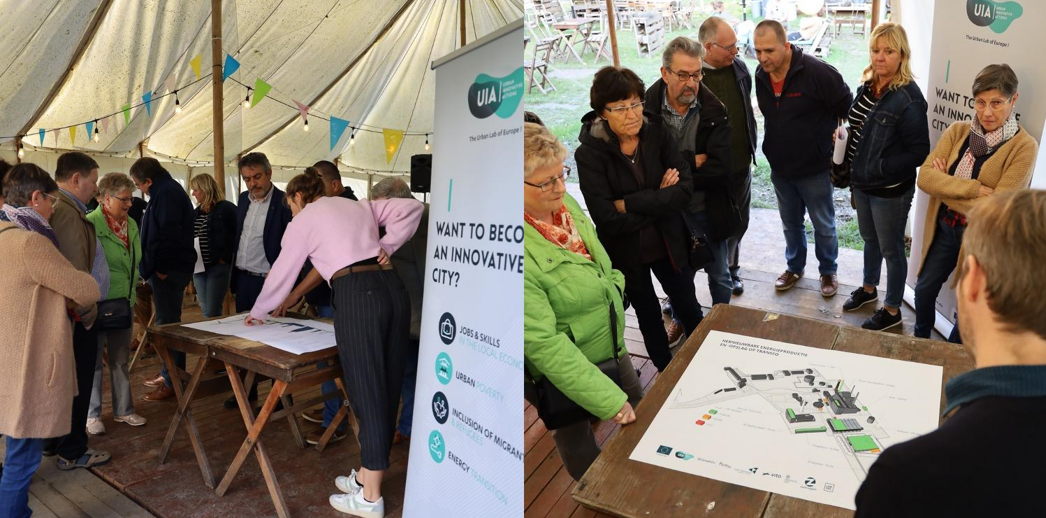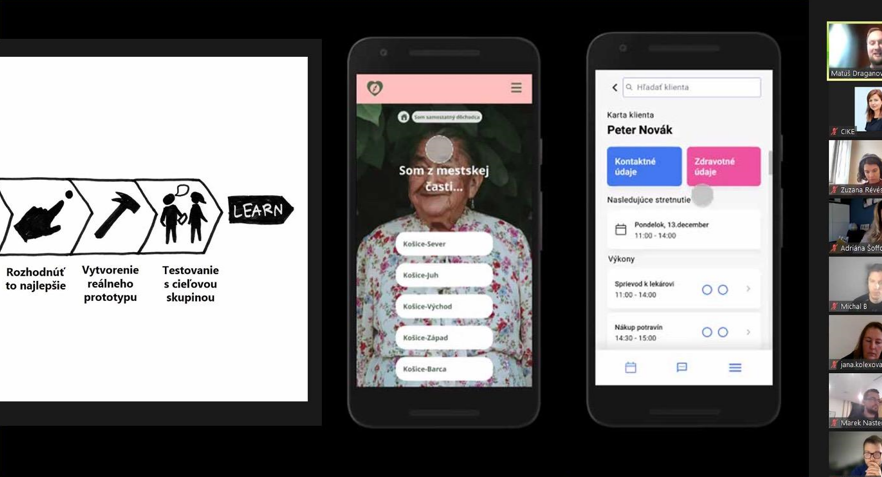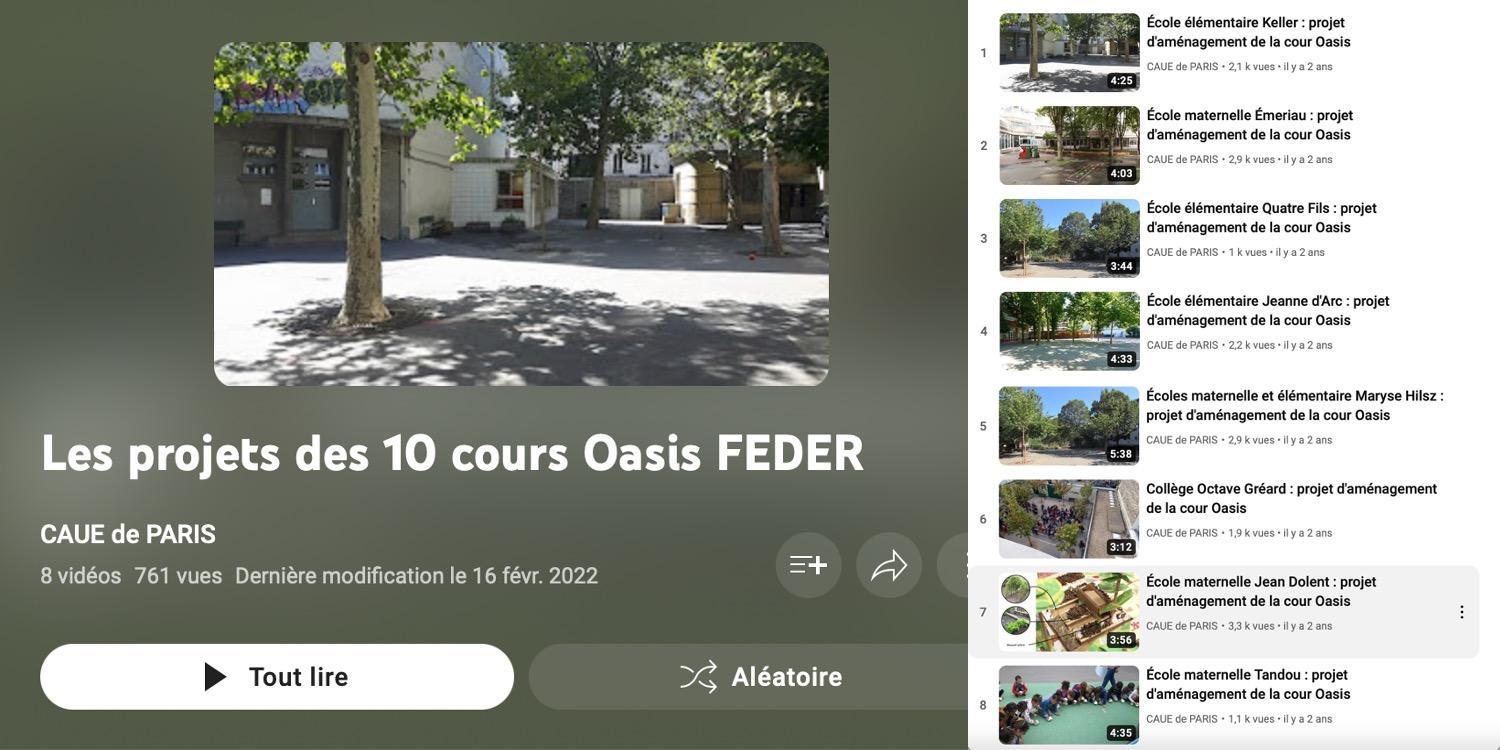Challenges - Citizen & Stakeholder Participation
The pandemic stopped processes in their tracks and led to questions about goals
Most UIA projects rely on or seek to foster citizen participation, co-creation with stakeholders, and inclusivity, etc. These processes, which are both means and ends, were severely undermined or even stopped in their tracks by the pandemic and the social distancing rules that were brought in.
- Social distancing undermined both how projects work and the goals they aspire to:
○ “Our project was based on co-creation with residents. Our goal was to set up a community in the New South neighbourhood” (Circular South project in Antwerp, Belgium). Building communities, gathering groups, getting closer took on a completely different meaning when socialisation was suddenly dangerous
○ Projects whose primary goal was inclusion and bringing people together were turned upside down when isolation, travel restrictions, and an absence of contact became a new normal on safety grounds: “Our project focuses on loneliness. Community dynamics and social relations are the basis of most of the actions we propose[...]” (STEPS project, Verona, Italy)
Project design and social cohesion activities were impossible during lockdown periods: “For example, building a high-tech mobile experience room, a sort of cultural interface where people can experience culture in their neighbourhood, in a period when nobody is allowed to go outside except for necessary activities, isn’t possible” (CoGhent project in Ghent, Belgium).
○ The added-value of close proximity in innovative urban solutions failed: “The difficulty of showing the population the benefits of the project in person and being able to contact them to resolve their problems” (Brick beach project, Velez-Malaga, Spain).
○ “One of the aspects of the project was to create moments and spaces of cohesion with the inhabitants of the project area” (A Place to Be-Come project). The project’s ultimate expected goals needed to be re-discussed.
● It was impossible to implement key components of some projects
○ “One of the objectives of the project was to launch an energy cooperative/community [...]” (RE/SOURCED project, Leiedal, Belgium). Even projects not primarily social in nature but relied on social contact to progress were undermined by social distancing.
○ With some of the core activities cancelled, the development of certain projects, such as coaching and training sessions, could not proceed: “two participating partners had to organise training and coaching sessions for families and professionals in order to help them use cargo bikes” (CAIRGO BIKE, Brussels capital region, Belgium).
○ Other activities, such as study visits, were postponed, putting the project partially on hold: “Because of the pandemic, the travelling options are limited, so the study trips are delayed” (Košice 2.0 project, Košice, Slovakia).
○ “The project’s launch was supposed to be a large-scale event for publicity purposes but was extremely limited due to the restrictions imposed by the pandemic” (WESH project, Heerlen, The Netherlands). Other key-activities took place but at such a different scale that they compromised the development of the project.
Difficulties with reaching out to target users and beneficiaries
Two years after COVID, a new normal has emerged which incorporates this threat into the daily life of European societies. When it first appeared in early 2020, COVID-19 was an unprecedented emergency which impacted normal life. It triggered changes in the way we live and work, and in how we interact physically and it remains a major preoccupation for people, leaving much less mental space for other activities. At least to some extent, it has called ‘business as usual’ into question. This said, although some activities were compromised (see #1 above- for example) participation did continue and even flourished in some respects, but its form changed radically; it went online.
● Low impact of project communication
○ The news media, saturated by pandemic concerns, monopolised everyone’s attention. No mental space was left for project communication. Priorities had simply changed: “we continued the large communications campaign we had planned. But with the lockdown, its impact was low with nobody in the streets in times of lockdown, and the recruitment of owners and tenants was lower than we expected” (Yes we rent project)
● A shift of focus away from participation
○ Intense online participation around COVID-19 concerns shifted the attention of the population away from UIA projects. “Trying to get citizens to participate in the project's activities became very challenging” (HOPE project, Helsinki, Finland) and resulted in a “lack of interaction with citizens and potential beneficiaries” (EPIU project)
○ This shift in the population’s attention particularly affected projects that were heavily reliant on active participation: “it is necessary to have enough meetings and participation sessions with the end users and future participants. Because of COVID, this was not possible” (RE/SOURCED project)
● Less engagement from participants
○ Consequently, as well as less participation, projects had to deal with a lower level and quality of participant engagement: “Participation and engagement became challenges because we were unable to organise in-person activities” (Green Minds project in Plymouth, United Kingdom).
○ A lack of engagement is always problematic but it is critical at the beginning of a project when it tends to affect the entire project’s development: “the main issue for the project has been end-user involvement, participation and research in the preparatory phase” (CoGhent project).
○ In particular, the engagement of disadvantaged target groups, who are more comfortable with face-to-face interaction and who lack digital skills, was particularly impacted: “Engagement actions have been complicated with COVID-19, as it is more difficult to reach those groups of citizens who do not use the internet” (Air-Break project, Ferrara, Italy); “It was just very hard to reach vulnerable home-owners online. So we tried to meet them at a safe distance at schools, with free meal facilities” (ICCARUS projects).
● Less HR available for human-based participative processes
○ Pandemic emergencies commandeered most of the workforces in cities, both from public and private actors. Projects’ participation processes, which are very demanding in terms of human resources, were the first to be put on hold: “disruptions in the delivery of public services, for example, social services, leading to certain departments having less capacity to get involved in EPIU”.
Online interaction cannot be the same as face-to-face interaction
The only alternative way to implement participation processes during successive lockdowns was to shift to online support. This shift created, at least at first, a feeling that human interactions had been degraded as well as frustration with the cold online substitute to face-to-face participation. Being forced to use online alternatives has led to assessing the value of online participation against the benchmark of face-to-face participation. However, this overlooks the potential benefits of online interaction for citizen participation and stakeholder engagement.
● Online is less of everything!
○ The copy-pasting of face-to-face practices onto online tools caused many difficulties and much disappointment. Projects struggled to reach potential participants through online channels, which took longer. “We needed to really actively search for participants, which was very difficult during periods of partial/complete lock-down” (ICCARus project, Ghent, Belgium).
○ Active stakeholders accustomed to direct face-to-face practices reported online processes to be less straightforward and more time consuming: “we started to work on non-face-to-face tasks and communication activities were slowed down” (Gavius project).
○ Online human interactions have resulted in less effective participant engagement: “workshops and brainstorming sessions are just much more effective in person than online” (CUP4CREATIVITY project, Budapest Újbuda, Hungary) and poorer collective results: “There was less community building” (ICCARus project).
● Human interaction needs more than bandwidth!
○ Participation is directly associated with people gathering in one place and powered by stimulating human interactions. Body language, eye contact, etc, and the non-verbal communication mechanisms that play such an important role in human interaction are missing online: “Also a lot of younger people work at Organiq non-for-profit organisation, and they need social interaction to be productive. COVID-19 caused a lower output than usual due to online working” (P4W).
○ Consequently, the absence of non-verbal communication made collaboration more difficult: frequent misunderstanding, a lack of spontaneous convergence, difficulties with building trust and reaching agreements: “We need a lot of personal contact with those vulnerable owners and we need to earn their trust, which isn’t possible through online mediums, especially with our target group” (ICCARus project).
● Lack of digital maturity (access to and use of digital tools)
○ Good quality online tools such as web-conferencing, webinars, digital whiteboards, etc. were already available when the pandemic struck although were not widely used by the public. Their use and adaptation to participation in projects was not straightforward and required capacity building and preparation: “we had to adapt some training content to an online format and postpone other BC LABS because it was impossible to do it online (like floor installation BC LAB)” (MILMA project).
While the penetration rate of digital equipment was quite high in most population groups, especially for mobile devices, the quality of connections, the availability of quiet domestic spaces, a familiarity with devices enabling people to adapt new applications, and overall digital literacy was not conducive to participation: “Participants had to adapt to a digital environment quicker than in a normal situation because most of the training was online” (MILMA project).
Reduced co-design in project solutions
Beyond regular participation aimed at collecting opinions, taking part in a trial or testing a new solution, intensive participation activities such as co-design were critical. The richness of face-to-face participation is a prerequisite for the close interaction required to involve citizens in creative processes, to make them feel comfortable, to create a normal interactive environment between them, smooth-out emerging tensions, and streamline conflicts in constructive processes.
A reliance on face-to-face interaction
- “During the COVID-19 period, we were not able to hold events with people, so it was much more difficult to gather opinions” (CartujaQanat project, Sevilla, Spain). If participation is on hold, this tends to affect a project’s direction.
- The more project design relied on the inputs of citizens and/or external contributors, the more exposed/impacted it was to the COVID-19 restrictions. Projects using an extensive co-design approach found it more difficult to reach the specific groups they had originally intended to involve, making it difficult to take design decisions. “the Neighbourhood Steering Platform [that could not gather data during lockdown] provides input for various parts of the project (Super Circular Estate project).
Delays in co-defining project & solutions
- As they are very demanding in terms of the quality of participation, co-design activities had to be postponed. “the local population's engagement in the project stayed low [...] the program took off among the citizens much later than what was initially planned” (Cultural H.ID.RA.N.T project).
Challenges in testing and monitoring
- Beyond affecting initial phases, engagement was an issue throughout the project, including for trials, iterative testing, simply making progress and final assessments. “We were not able to meet face to face with our target groups. This made it difficult to test the tool and to commit testers (jobseekers, intermediates/HR professionals and employers) to the process” P4W
Active participatory methods need to be re-invented
- “The COVID-19 pandemic had a major impact on our co-creation process and forced us to look for alternative and innovative solutions adapted to confinements” (GAVIUS project). Projects were forced to innovate in the very participatory innovation approaches they used!”
- Co-design approaches use highly interactive facilitation skills and use collective intelligence carefully, i.e., methods that are time-consuming and difficult to reproduce in remote situations. “Most of our project's WPs involve citizens' engagement, and active participatory methods. So the main problem we faced was finding alternative ways to organise this participation” (Cultural H.ID.RA.N.T project).
Responses to Challenges - Citizen & Stakeholder Participation
The ‘culture of participation’ comes from and is associated with face-to-face interaction for plenty of good and bad reasons. On the one hand, deliberation has historically implied meeting physically in the same place, so the culture of participation developed hand-in-hand with the values of face-to-face interaction, debating in agoras, verbal eloquence, eye contact, body language, etc. These are the conditions that create rich human interaction. On the other hand, even before COVID-19 pandemic, this culture of physical participation tended to clash with:
- a lack of time to take part in physical gatherings
- a difficulty with identifying simultaneous availabilities between different categories of the population
- the attendance of usual suspects
- the systematic absence of the same unheard voices
- a reluctance to experiment with non-face-to-face interaction or mixed communication channels; etc.
A crisis of any kind brings with it a host of new problems that an innovation project must confront. As commentators on the energy crisis in the 1980s pointed out at the time, the word crisis in the Japanese language is composed of the ideograms 'danger' and 'opportunity', which suggests that a crisis is also an opportunity to rethink an innovation project’s processes and stakeholder practices. Confinement and social distancing have allowed UIA projects to investigate and experiment with approaches to citizen participation and stakeholder engagement. While confronting the dangers of the pandemic, they have seized opportunities to innovate:
● The big move outside
○ Projects dared to transpose participation and engagement from what was planned inside, to outside “organising outdoors events in parks or in less critical periods” (A Place to Be-Come project), “doing meetups for the project in a public space” (Košice 2.0 project) and not even letting the weather get in the way: “we organised test sessions outside even during winter” (Cairgo Bike project).
● Exploring new forms of social gathering
○ Temporary events turned to more permanent forms of outdoor interaction: For example, EPIU set up information stands on the streets to facilitate contact-based activities with citizens (Getafe, ES) and RE/SOURCED set up a ‘physical info market’ outside on the project’s Transfo site (Zsevegm, BE).
| A Zoom into the Projects RE/SOURCED, City (Zwevegem, BE) - INFO MARKET
After the pandemic reached its highest (or lowest) point, we decided that we could no longer wait to inform the inhabitants and to discuss the plans with them, especially about the wind turbine. We therefore organised an ‘info market’ for nearby residents and users between 4pm and 7pm, to be able to reach as many people as possible. The info market was held on site, in a very informal setting (the summer bar located at Transfo). Colleagues involved in the project were present to give people the information and answer their questions. A drink was offered to create an informal and agreeable atmosphere. People were really interested and were quite positive about the project. Considering the circumstances at the time, this was one of the best ways to handle the situation and to inform everyone about the project. In April of this year, we are planning to use the same method for a new info market for the RE/SOURCED project. |
Downsizing the groups
- “The rules about the permitted number of people changed several times. We organised test sessions outside with smaller groups” (Cairgo Bike project). The changes to rules on gatherings in public spaces forced project participation leaders to downsize groups.
- This downsizing pressure from the pandemic even pushed projects towards individual forms of interaction, turning the collective sense of participation upside-down: “We support families individually” (CAPACITyES project, Bergamo, Italy), “we had one-to-one meetings with key representatives of neighbourhoods, schoolteachers, NGOs” (SPIRE) or “we held co-design session in smaller groups than the ones planned, not a class but 5-6 kids” (CAPACITyES project).
- One of the common biases in the face-to-face based culture of participation is the focus on the quantity (the number of people taking part), rather than on the quality. The limit to the size of groups imposed by the pandemic helped to appreciate the advantages of “micro-participation” (smaller groups): “Walking interviews instead of neighbourhood meetings brought very rich results” (CoGhent project). However, downsizing the participation format caused more work for planners: “The amount of human resources available remains the same, smaller groups means less time for each group” (Cairgo Bike project).
Projects are still very busy catching-up after COVID-19 and have probably not all yet had enough time to see what this outdoor push has changed. We might mention, for example, more visibility in public spaces for the participation process: it is more open to different categories of the population, affords better spontaneous access to unusual suspects, and may simply be more fun: “For the National Cleaning Day, we organised a lunch in a park that had been initially planned in a building: there were fewer people but there was a good atmosphere and its was more viral” (WESH project).
Beyond more work and organisational difficulties, this experimentation with new forms of outdoor interaction has ‘opened the door’ to more open, agile, and creative approaches to participation and calls into question why participation is assumed as already being adequately facilitated by default and especially why it is mostly a question of asking people to come to one specific place (and often a ‘place in the city’, a facility of the town hall, a public meeting room in the neighbourhood, etc.) rather than reach out to the population where they live.
Any crisis produces defensive reactions that result in the development of new ways of coping. The response to successive lockdowns has triggered an explosion of collaboration and e-work technologies to rebuild forms of work and collaboration over a physical distance. Remote cooperation and participation have disadvantages but also advantages over face-to-face approaches: they are just different. Transposing online what was done face-to-face is not the right approach. Those involved in participation in general, and in UIA urban innovation projects in particular, have had to reinvent ways of organising participation by taking advantage of the benefits of digital technologies, while avoiding the drawbacks. Online citizen participation and stakeholder engagement has gradually moved from a simplistic transposition (from face-to-face to online) to a thoughtful project.
- Adapt and make good use of traditional forms of communication
- Online is different from face-to-face and copy-pasting good off-line practices to online generally results in weak and disappointing results: “e-peritifs, online challenges, DIYs at home…Despite many attempts to switch project activities online we did not get much response” (Circular south project).
- Making intelligent use of what your target groups know turned out to be a better strategy, i.e. city news media, messaging, telephone, etc. even with low bandwidth or low interactivity, this did the job: “Because of digital use limitations with older people, we also conducted small co-creation-oriented surveys by telephone. Having staff to provide face-to-face support to citizens also helped” (GAVIUS project)
- Support new digital participation
- The same attention should be provided to inclusion to ensure balanced participation online: “no one was left out of the training [...] we paid more attention to those who had lower digital skills” (MILMA project).
- In particular, bridging the digital divide is a major challenge for online participation: “we bought laptops and Internet data to facilitate the participation of people with fewer resources in the lockdown” (MILMA project).
- On top of ensuring connectivity, an important effort should be made to facilitate personal access and online skills: “We carried out your digital capacity building activities to counter isolation” (STEPS project).
- Redesign participation using all the capabilities of digital platforms/interfaces
- Each activity requiring participation needs to be reinvented online from scratch: For example, GREEN MIND developed online tools to build engagement and switched to online prototype development (Plymouth, UK), Cultural H.ID.RA.N.T organised online workshops for schools” (Halandri, GR); and Košice 2.0 redesigned the Design Sprint in an online form (Košice, SK).
- Key challenges are to:
- mix different channels to create a richer working environment by mixing tools to add text, voice, digital board: “Zoom discussions/debates + Google Jamboard to enable proposal panels to assess public space interventions + online questionnaire” (SPIRE project).
- increase interactivity, for instance using synchronous inputs from all participants at the same time (collaborative writing, parallel discussions on chats, open subgroups, mixed tasks, etc.) which is much easier online than offline.
- Digital fatigue and low stimulation of multi-users in online meetings require effort and imagination to keep participants interested: For instance, Košice 2.0 explains that they had to “design the session to keep people active, changing rhythm and switching regularly between tools: plenary/small groups, collective/individual, verbal/silence, short activities/longer discussions, attention check/pool voting, etc (Koši, SK).
- It is a good idea to diversify channels of communication and optimise the diversity of digital material available: “we created many available online resources (videos, general assemblies, booklets etc.) to reach the beneficiaries” (OASIS project); “interviews and situational games for online selection of beneficiaries families” (CAPACITyES project).
| A Zoom into the Projects Košice 2.0,Košice (SK) - ONLINE SPRINT
The idea of the Design Sprint is to build and test a prototype in just five days for all the phases of the sprint: making a map and choosing a target; sketching possible solutions; choosing the best one; building a realistic prototype and testing it with the target customers. Because of the COVID-19 restrictions, when we switched to online, we had to rebuild the original idea, shortening the timeframe to keep people engaged and using online tools such as Miro and Google Jamboard, or Figma. In the end the sprint was condensed to 12 hours in a facilitated online environment and in a hybrid way in order to also complete practical tasks in the field. We had to plan the specific slots to get input from the decision-makers or users at the right time, to organise a good schedule for fluid process and to design icebreaking activities at the start to create a comfortable atmosphere and open-minded approach, which are essential in this type of workshop. |
| A Zoom into the Projects OASIS, Paris (FR) - ONLINE RESOURCES
We had many requests for information about what is available online. We created documents to share the links, etc. The videos we created about the project were not really planned at the beginning (only 3 videos were planned, and we have about 20 now). Many of them were created for our second general assembly, which had to be online in July 2020. Websites dedicated to the remote monitoring of the construction site were also made because site visits were not possible. We believe it was really helpful to inform people about the project's news and we had considerable positive feedback on the content we provided. |
-
- Last but not least, very careful preparation before any online interaction is needed (tech checks, online support, multiple dry runs, etc.) “we prepare engagement tools before the meeting” (A Place To Be-Come project).
A crisis such as COVID-19 produces a period of adjustment during which the new normal that takes hold coexists with reminiscences of former practices: the successive periods of lockdown and partial reopening that followed created a succession of very disturbing jolts for the UIA projects. But it also allowed them to experiment to get the right balance between face-to-face and remote participation, and gradually to validate a set of operational criteria for a hybrid mix of participation that is more suitable for citizen engagement and project-actor cooperation than either all-face-to-face or all-online options.
The main advantages of online participation, according to UIA projects, are:
Unexpected benefits
- Our analysis shows that under each of the 3 UIA project delivery themes studied, pandemic conditions were a strong accelerator of ongoing digitization with both positive and negative results. In particular, compulsory online interaction had unexpected positive effects on participation: “training results were better because they had all the time to practice. In addition, we noticed that those who were forced to train online learned more quickly than those who did not (MILMA project)
More flexibility
- Among the advantages for participative processes, digital media can help stakeholders to adapt to unforeseen hurdles in ways not otherwise possible i.e. “possibility to connect even during a break at work” (GAVIUS project); “online allowed more flexibility to adapt school’s morning/afternoon schedules” (EPIU project)
- This flexibility can help overcome stakeholders’ constraints and increase opportunities for participation: “it’s possible to more easily create a schedule for a meeting for a very busy authority (no transport and no coffee discussions, etc.)” (APTBC); “reluctance to attend talks and workshops” (EPIU).
Wider outreach
- Online connectivity and flexibility can lead to increased participation “we managed to involve larger audiences” (Brick Beach project) resulting in greater numbers of people actually getting involved: “by switching the activities in the online (educational programme for the municipality, workshops, meetups for community, events, etc.) we had a pretty good number of participants” (Košice 2.0 project).
- It also allows for a wider (geographic) outreach: “because participants from much further away joined in who would otherwise have missed it” (WESH project) and more diverse audiences: “we managed to involve students in online environment activities” (Air Heritage project, Portici, Italy); “more participation of colleagues from the city administration” (CAPACITIES project); “online tools which actually resulted in new audiences” (GREEN MINDS project).
And the main disadvantages for online participation according UIA projects are:
Lower participation quality
- The initial engagement is critical: “Starting something online is much more complicated” (Cairgo Bike project). Having larger number of participants can create a negative feeling of more superficial exchange: “it allows maybe more people to join in but makes it more difficult to really engage in discussions with stakeholders we don't meet often” (Cairgo Bike project). More shallow online interaction makes mutual understanding and agreement less straightforward: “It is also more difficult to judge if the meeting was interesting for people” (Cairgo Bike project)
- It makes certain project participation activities more difficult to run online. For example, “drafting design ideas digitally was difficult” (SPIRE project)
- In particular, if the online web conferencing and webinars serve one-to-all broadcast communication pretty well, bilateral conversations creating links between participants are more critical: “it’s very difficult to create synergies among the stakeholders/participants”, “good number but no network” (Košice 2.0 project).
- Online participation doesn’t mean that the attention is there: “having many people doesn't mean everyone is actually listening” (Cairgo Bike project) resulting in new forms of latent attention: “Online, people tend to take part as if they were listening to the radio, it’s less interactive” SAS MOB
Less engagement in the long run
- Massive engagement also means massive drop out: “sometimes massive invitations implies that attendees drop out at the last minute” (EPIU); “more people know the project (online presentation, online dissemination events, etc.) but they were less committed” (CAPACITyES project)
- Participation is more difficult to maintain over time: “stakeholder engagement deteriorated more quickly compared to face-to-face” (WESH project); “negative effects i.e. less constancy” (GAVIUS project)
Fewer connections with disadvantaged communities
- The digital divide both in terms of equipment and skills remains a high barrier for underprivileged segments of the population: “Difficult to reach low-income communities without internet connection” (SPIRE); “one pilot site was located in peri-urban areas, with low-income communities, the participation was low” (SPIRE)
- Increasing familiarity with digital interaction is less likely due to different participation practices: “engaging project workers with online meeting games was possible but it was impossible to use them with citizens” (A Place to Be-Come)
- Betting on a hybrid mix: “a new plan was created: mixing online activities (such as debates, discussions, presentations) with one-to-one meetings, and when possible physical workshops” (SPIRE). Projects started to mix face-to-face with online participation using the best assets of each. “We carried-out a set of co-design hybrid workshops and trained participants for these” (SPIRE project).
The conditions imposed by the crisis forced a drastic change in the practices of actors involved in urban innovation projects. Exceptions in an emergency, inventiveness in dealing with emerging problems, concessions, deviations from the rule, these are all experiments outside the norm and can be accelerators of change. Yet the opportunities to do things differently have the unfortunate tendency to dissipate when the intensity of the crisis diminishes or a new normal takes hold. The UIA’s innovative urban projects have sought to identify which of these new participative practices constitute an improvement and to make them default practices in their cities and beyond.
- The digitization boom
- After the pandemic, as for all dimensions of social interaction, citizen and stakeholder participation has radically changed and should be considered in a more comprehensive way: specifically, opening it up to digital media: “The majority of partners meetings are now carried out online” (CAPACITyES project)
- Remote participation is becoming much more acceptable and accepted: the traditional forms of face-to-face participation that public authorities often organise should be enriched with public consultation websites, participative project webinars, stakeholder online dialogues, etc., “online training not only with external institutions but also in the municipality’s departments (social services, health and others with relations with citizens)” (EPIU project)
- A balance between (1) enhancing digital approaches in all communication and dialogue with the public: “free to use QR codes in communication tools and results” (A Place to Be-Come) and (2) going too far due to public budget limitations pushing for an over-digitization of participation through, for example, the explosion of ‘civic tech’, which risks reducing democratic debate to comments on social media and referendum democracy.
- Designing the most efficient combination
- The question is now not so much a choice between on/offline options but a choice between online and face-to-face platforms as discussed in the previous section: “online meetings to get solutions and ideas faster [...] especially with institutional partners” (EPIU).
- Citizen participation, stakeholder engagement, public co-creation, etc. should become more and more a matter of designing the best and most efficient combination: “we used a hybrid format for the meetups/events for the CCI community: the positive effect was that more people can participate… and we do the coffee ‘cheers’ online :)” (Košice 2.0) and consequently participative processes should be equipped for hybrid, multi-channel, a/synchroneous interaction in order to reach as many different population groups as possible: “we invested in a conference room to facilitate hybrid sessions” (APTBC).
About this resource
The Urban Innovative Actions (UIA) is a European Union initiative that provided funding to urban areas across Europe to test new and unproven solutions to urban challenges. The initiative had a total ERDF budget of €372 million for 2014-2020.
Similar content
